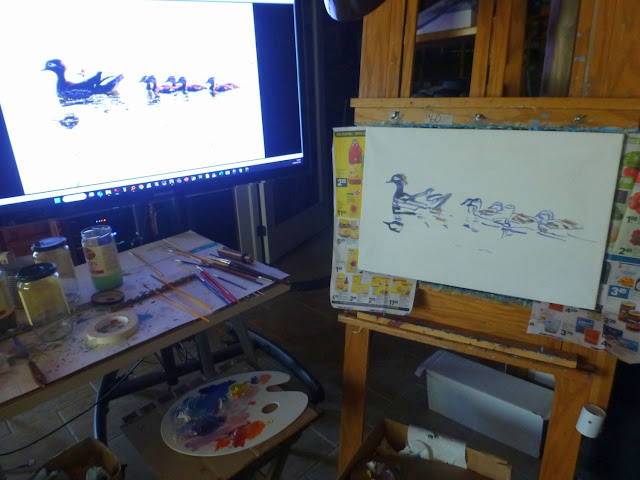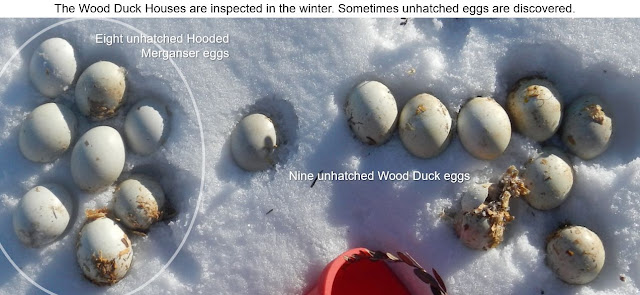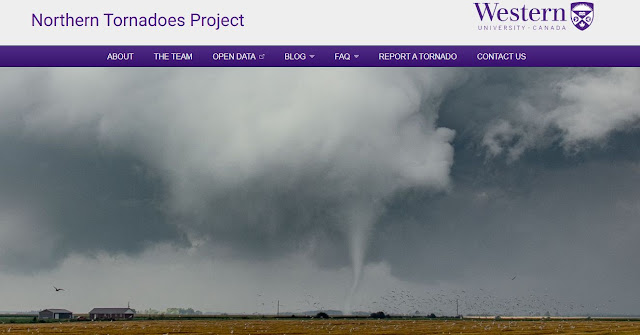 |
#2961 "Froggy Friend"
16 x 20 by 3/4 depth stretched canvas (inches)
Started 10:00 am Monday, July 14th, 2025 |
This is another image taken by my friend, John Verburg, a naturalist and terrific photographer. John provides a tremendous source of inspiration that encourages me to paint within the Singleton Studio when conditions outside are not conducive to plein air. A Heat Advisory was in effect, and the smoke from the Boreal forest fires was arriving to make the air quality unacceptable. The biting bugs were also hungry. It was a good time to be in the Studio.
Listening to the frogs is a favourite "
life in the slow lane" activity at Singleton. Many thousands of spring peepers in the adjacent Provincially Significant Wetland (PSW) announce the coming of spring with their loud, high-pitched cheeps. We eagerly await that sound, which typically arrives during the first week of April.
The timing of frog calls varies by species, but generally starts in late March in southern Ontario and continues into the summer. Spring peepers, wood frogs, and chorus frogs are among the earliest springtime singers. Larger frogs like bullfrogs and mink frogs call later in June and July.
Male frogs croak to get the attention of a female frog, even if they don't see or hear one. We would relax on the red chairs overlooking the lake and eavesdrop on the froggy conversations. The "Jug-O-Rum" croaks of specific bullfrogs were distinctive from their various shoreline territories. The melodies carried across the open waters to their competitors, who would invariably answer back. The conversations between some frogs would escalate into shouting matches across the lake. Their voices would carry far and wide, especially during quiet evenings.

Around 2012 (I forget the exact year), the Singleton bullfrogs were silenced in a single summer. Apparently, someone had developed an insatiable taste for frog legs. We silently and sadly witnessed the extinction occur. At dusk, a boat with spotlights and a couple of occupants would poke slowly along the shoreline. The evening serenaders were targeted one by one. This tragedy occurred most evenings that summer until the frog songs were extinguished. The extermination of the Singleton bullfrogs was legal, but does that make it right?
"Bullfrogs may be taken for personal consumption under the authority of a valid sport or conservation fishing licence. No commercial harvest of bullfrogs is permitted. The only firearms permitted for harvesting bullfrogs are bows (for example, compound, recurve, long or crossbow). A person may take bullfrogs at night without a firearm and may shine a light for that purpose." https://www.ontario.ca/document/ontario-hunting-regulations-summary/small-game-and-furbearing-mammals
Apparently, bullfrog hunting as described in the above government publication is even permissible within a Provincially Significant Wetland. We have several such wetlands on our property, separated by hardwood forests.
I can't imagine anyone requiring those calories so desperately! Globally, the harvesting of large frogs for food has led to serious declines in several species, including the American bullfrog. Frog legs were popular menu items in the 1980s and early 1990s. Harvesting for both food and educational purposes (i.e., dissection) has simply and tragically decimated native bullfrog populations in many wetlands.
Woefully, our froggy friends were "harvested" into local extinction. Clearly, such activities are not sustainable. In my opinion, the distinctive "harumpf" of the bullfrog voice is as vital as the haunting call of the loon to the Canadian environment.
 |
| Steve Irwin, known as "the Crocodile Hunter", 2005 |
"
We don’t own the planet Earth, we belong to it. And we must share it with our wildlife.” – Steve Irwin, renowned Australian wildlife expert and conservationist.
The following map tracks the comings and goings of bullfrogs relative to 1998. The red squares indicate where bullfrogs were present before 1998 but not after that date. The yellow squares are where bullrogs have expanded their range after 1998 into areas where they had not been previously detected. Bullfrogs were found in the blue squares both before and after 1998. It is unknown whether their overall numbers are increasing. The red squares outnumber the yellow squares.
 |
Singleton is located on the above map near two red squares (yellow arrow) surrounded by blue
squares. The actions of just a few frog hunters can have serious impacts. |
Making something legal does not make it ethical. Tragic examples abound in our current capitalistic economy and cataclysmic governments. Democracy relies on the integrity and honesty of elected representatives to behave according to their party platform and policies within the laws of the land. Tragically, that is not always the case. There are numerous glaring examples of individuals with the worst qualities holding public office. Laws are changed to suddenly make their misdeeds legal. Greed and power are the motivations. Shame.
A few empathic and passionate champions are vital to keep the country on track to a sustainable future for all, not just for the wealth and power of the elite few.
"Power tends to corrupt, and absolute power corrupts absolutely" was written by Lord Acton (John Dalberg-Acton, 1st Baron Acton), in an 1887 letter to Bishop Mandell Creighton. The words still ring true more than a century later.
Now for some biological facts.
- The American bullfrog, the largest frog in Canada, is native to southern Ontario.
- They are typically found along shorelines of lakes, bays, and slow-moving rivers, preferring areas with deep, permanent water.
- Bullfrogs are known for their deep, bass call, which sounds like "Jug-O-Rum".
- The bullfrog varies in colour from pale green to dark greenish brown above, is creamy white below and has variable dark mottling on the back or underside.
- Adult males have pale to bright yellow chins during the breeding season.
- Bullfrogs are distinguished by their very large tympani (eardrums), which are always larger than the eyes, especially in males.
- Bullfrogs have lateral folds, but, unlike in other frog species, these folds wrap downward around the tympani rather than trailing down the back.
- Adult bullfrogs may grow up to 16 centimetres long.
- Bullfrogs breed later than most other frogs, usually from mid-June to late July on warm, humid or rainy nights.
- The egg masses may contain up to 20,000 eggs and, when first laid, spread out over the surface of the water.
- Bullfrog tadpoles, which grow for up to three years before changing into frogs, eat suspended matter, organic debris, algae, plant tissue and small aquatic invertebrates.
- Bullfrogs reach maturity two to four years after transforming, and in the wild, bullfrogs are known to live up to 10 years. However, mortality is high during the first few years of life. In captivity, they can sometimes live longer, with records of some living up to 16 years.
- They are known for their voracious, indiscriminate appetite. Bullfrogs will eat virtually any animal they can swallow, including insects, birds, mammals, reptiles and even other bullfrogs. This trait makes them easy to catch.

It was a wonderful experience attempting to breathe life into the oil painting of a bullfrog. The following chronicles just a few of the steps. There were many more steps over a week of effort.
For me, art is a personal challenge. Each subject is unique and demands focus and concentration to succeed. I am the one who must be satisfied and am careful not to empower anyone else. I own either the success or the failure of the creative venture. Art, like life, is not a competition.
A portrait can be found in the eyes. Those googly peepers of the bullfrog had to be alive and following your every movement from the canvas. They had to be just right, and it took several days and some intense concentration.

The following image displays the studio arrangement on day six with two oil palettes and a slew of brushes that required some attention. An LED lamp was used to light my palette as the colours were getting tricky. I had to use some of my Stevenson's Quinacridone Crimson - not much left. My palettes were also getting somewhat messy. Time to regroup.
 |
John Verburg's photographic inspiration is displayed on the old TV screen,
and I pretend I am outside painting. I can be very gullible. |
The Singleton bullfrogs disappeared for many years. It has taken more than a decade, but the song of the bullfrog has partially returned to Singleton. We have started to hear some bullfrogs again in 2025... Let us hope that people will leave them alone to complete their interesting biology, as summarized above. That should be enough motivation to let them naturally thrive.
Warmest regards and keep your paddle in the water,
Phil Chadwick

 The female does most, if not all, of the nest-building, while the male keeps her company. If the cavity is much deeper than 12 inches, she first backfills it with debris before building her nest in the back of the remaining space. She uses a wide variety of materials, from grasses, leaves, twigs, and stems, to hair and fur, snail and seashells, feathers, bark, moss, cellophane, onion skin, paper, cloth, eggshells, and, quite commonly, shed snakeskin. The inner cup is usually 3 to 3.5 inches across and 1.5 to 2 inches deep. The female may continue to add fine materials, like feathers, to the nest during egg-laying, incubation, and brooding.
The female does most, if not all, of the nest-building, while the male keeps her company. If the cavity is much deeper than 12 inches, she first backfills it with debris before building her nest in the back of the remaining space. She uses a wide variety of materials, from grasses, leaves, twigs, and stems, to hair and fur, snail and seashells, feathers, bark, moss, cellophane, onion skin, paper, cloth, eggshells, and, quite commonly, shed snakeskin. The inner cup is usually 3 to 3.5 inches across and 1.5 to 2 inches deep. The female may continue to add fine materials, like feathers, to the nest during egg-laying, incubation, and brooding. 














































